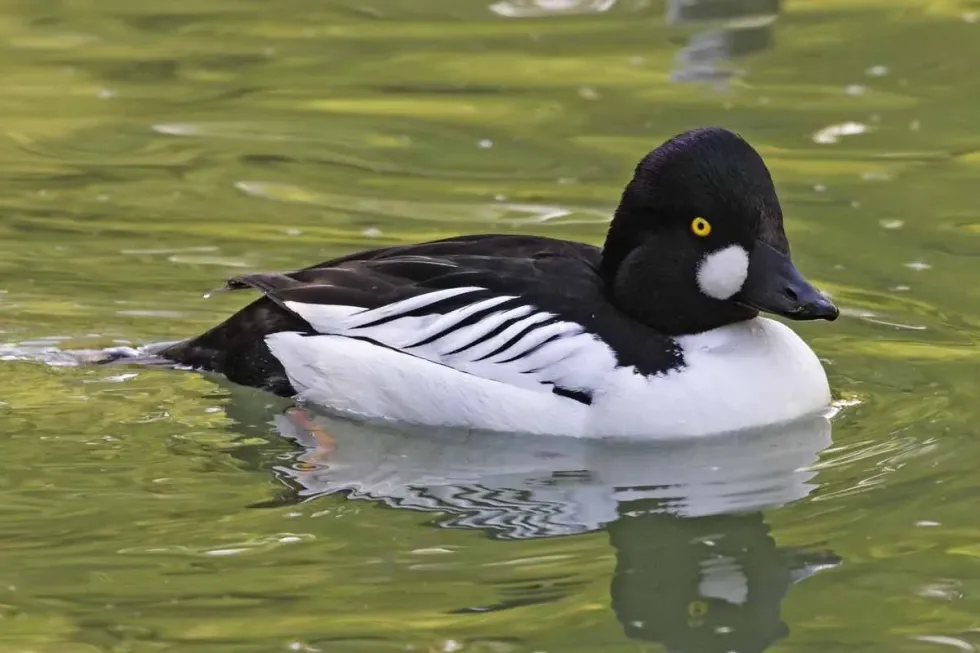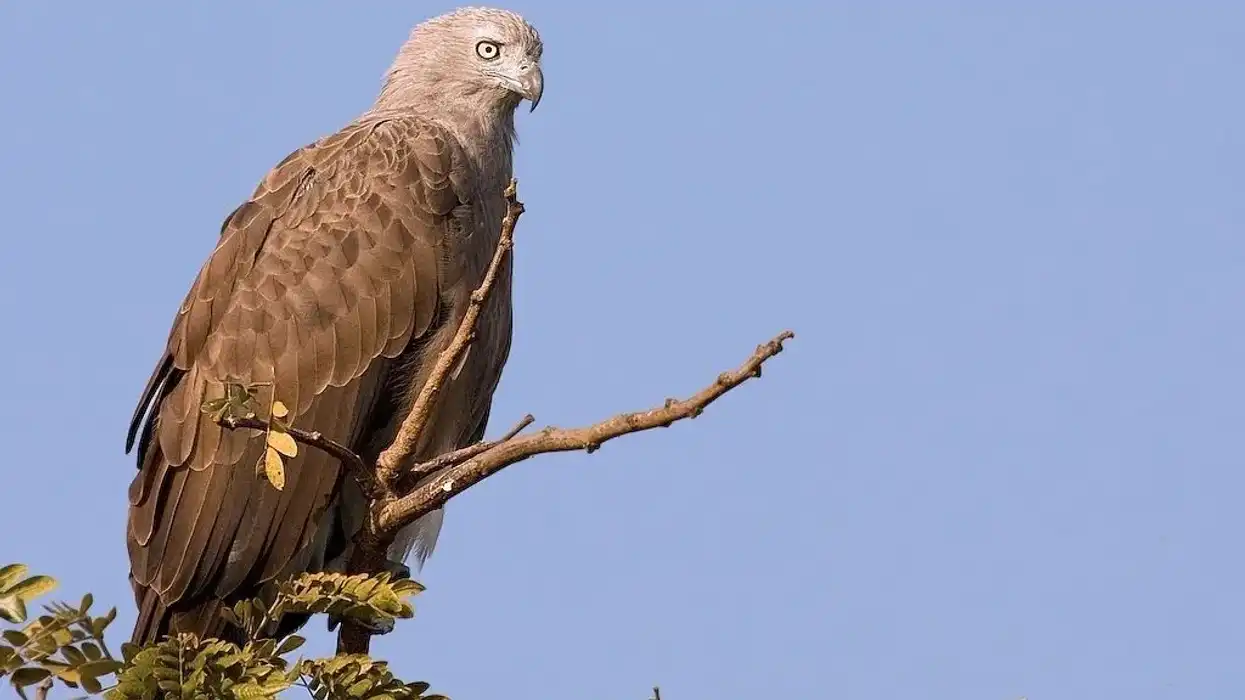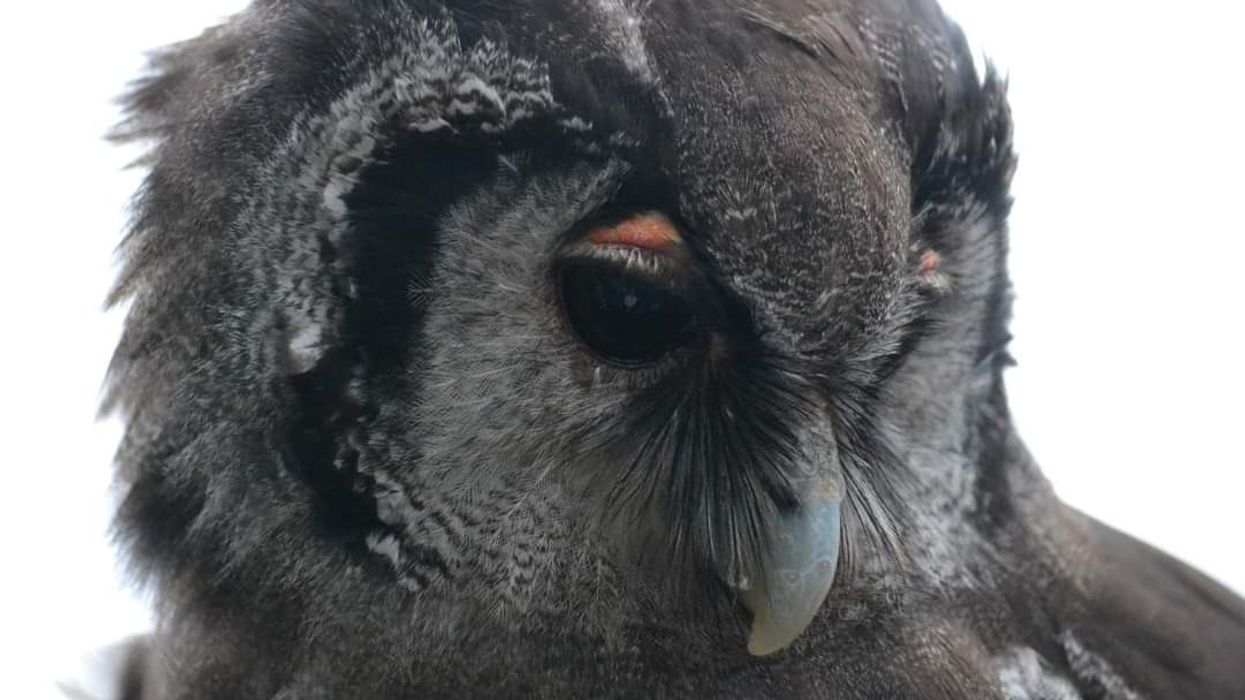Found in the rivers and lakes of North America and Eurasia and belonging to the Anatidae family, the common goldeneye is quite widespread.
These birds are one of the few colorful and adorable-looking ducks. They have a black-colored back, tail, and wings, and white-colored breasts, sides, and belly.
Males have a greenish-black colored head, while females have a brown head. Males also have an oval-shaped white patch at the base of their bill alongside their bright golden iris which gives them their unique name.
People often get confused between the common goldeneye and Barrow's goldeneye, also known as the common goldeneye drake. The Barrow's goldeneye vs. common goldeneye confusion has been around for ages.
Although they look almost identical, the bill of a Barrow's goldeneye is orange in color. Goldeneyes are rivals with fish which is why they are easier to spot in lakes that are devoid of fish rather than in lakes that are teeming with fish.
Keep on reading to learn more interesting facts about this species. Are you interested to learn about other interesting animals from around the world? Then don't forget to visit our articles on carrion crow and king vulture too.
Common Goldeneye Interesting Facts
What type of animal is a common goldeneye?
The common goldeneye (Bucephala clangula) is a species of duck living across many parts of the world. Just as the name suggests, a common goldeneye duck is quite common when compared to other species of goldeneye. The population of this North American bird has even increased in some parts.
What class of animal does a common goldeneye belong to?
The common goldeneyes breed belongs to the Aves group of the animal kingdom. These are among the most common birds in North America. However, they are spread across a large territory. Due to the unique common goldeneye characteristics of making a whistling sound while flapping their wings, they are also known as whistlers.
How many common goldeneyes are there in the world?
The exact number of common goldeneyes around the world is not known. However, they are among the most common birds in North America and can also be found in the lakes and rivers of Eurasia, Scotland, Scandinavia, northern Europe, and Canada.
Where does a common goldeneye live?
These diving ducks are found all across North America and Eurasia. However, during the breeding season, they migrate towards common goldeneye breeding grounds in northern Europe, Scandinavia, and Scotland.
They can also be found in parts of Canada, British Columbia, northern New York, and Michigan. After the breeding season, they leave the nest and breeding ground and migrate to coastal waters where they spend the winter.
What is a common goldeneye's habitat?
These common goldeneye ducks live in open-water lakes and rivers. They prefer rivers and lakes to be surrounded by mature forests where it is easy to find and nest in tree cavities.
Due to their nature of making nests and laying eggs in tree cavities, people in Scandinavia made nest boxes and hung them on trees around 240 years ago. The ducks used to lay eggs in those nest boxes and this made their eggs accessible to humans for consumption.
Who do common goldeneyes live with?
Common goldeneyes (Bucephala clangula) are social birds. Throughout the year, they can be seen and spotted in small groups.
However, during the breeding season, the male and female counterparts of these North American birds become very conscious of their territories. Through courtship displays, both the male and female counterparts of this species defend the breeding grounds containing the nest sites from other ducks. They do this by making noises to scare off any predators.
How long does a common goldeneye live?
A common goldeneye lifespan ranges from 11 to 12 years.
How do they reproduce?
During the nesting season, common goldeneyes (Bucephala clangula) form pairs and migrate to shallow-water lakes. The nesting season takes place between December to March.
Both males and females keep other ducks away from their breeding grounds containing the nest sites through different sorts of courtship displays. The head-throw-kick is the most unique courtship display out of the many ones that they perform. Males thrust their heads forward, then move back and make a noise to defend their territory.
Due to their abundance in northern boreal forests, it has been quite easy to learn about their breeding procedure. Using their characteristics of making a nest in tree cavities, researchers make nest boxes for the birds to lay eggs in.
Although they prefer to nest in cavities, nest boxes also serve their purpose just as well. Female common goldeneyes then create a nest bowl using various materials. In these nest bowls, they then lay a single clutch of eggs.
A single clutch has five to 17 common goldeneye eggs. A common goldeneye is female will lay eggs that are greenish to blueish.
The male leaves the female common goldeneye soon after the incubation starts. It takes the females 28 to 32 days to incubate the eggs. After that, the eggs hatch, and young ducks are born.
What is their conservation status?
According to the International Union for Conservation of Nature (IUCN) Red List, the common goldeneye species of birds come under the Least Concern species of animals. Although the population of the species is quite abundant across the world, climate change is posing major threats to these ducks.
Common Goldeneye Fun Facts
What do common goldeneyes look like?
These North American birds are medium-sized ducks. Their back, tail, and wings are black, while their breast, sides, and belly are white. Females have a brown head, while males have a greenish-black head and an oval white spot, just at the base of the bill.
However, their bright golden eye, which gives them their name, is their most unique physical feature. Males grow a little larger than females. The common goldeneye in flight produces a whistling sound through their wings.
How cute are they?
The colorful feathers and unique features give these birds not only a very unique but also an extremely cute look. Most of their unique appearance comes from their beautiful golden iris, which gives them their name. Although these ducks are mostly social, during the breeding season, they become extremely territorial and aggressive.
How do they communicate?
It is a mostly silent bird. However, during nesting, males become quite aggressive and outspoken. They make 'peent' sounds while defending their territory during the nesting season. On the other hand, females make 'gack' sounds during nesting to keep other ducks away from their breeding ground. Females also make this sound when they are annoyed.
How big is a common goldeneye?
The common goldeneye is a medium-sized bird. They grow up to 15.6-20.1 in (40-51 cm) in length. They are almost three times smaller than a swan.
How fast can a common goldeneye run?
The running speed of this bird is not exactly known. However, common goldeneye diving does not require much running. This characteristic also gives them their name of diving ducks.
How much does a common goldeneye weigh?
Belonging to the Anatidae family, these birds are medium-sized ducks. They weigh around 1.7-2.2 lb (0.8-1 kg).
What are the male and female names of the species?
Male common goldeneyes and female common goldeneyes do not have specific names.
What would you call a baby common goldeneye?
Similar to the males and females of the group, even the young ducks do not have a particular name. Young ducks go by the name of the parent species which is 'duck'. Young ducks can also be called 'common goldeneye ducklings'.
What do they eat?
Being omnivorous birds, they feed upon both plants and animals as part of their diet. On the one hand, their diet includes shrimps, crayfish, amphipods, crabs, mollusks, fish, blue mussels, marine worms, leeches, and frogs. Another large part of their diet includes plant materials, especially pondweeds.
Are they aggressive?
In general, these birds are not aggressive. However, during the breeding season, they are quite aggressive when protecting their territory.
Would they make a good pet?
There is no confusion about the fact that these birds look adorable. However, in no circumstance do they make a good pet. They are more comfortable living in the wild and try to avoid human contact to a great extent.
Did you know...
Although several preparations of duck are quite popular, common goldeneye meat does not have a nice flavor. Some even claim that common goldeneye duck meat tastes more like liver. However, some people also say that although their meat is not extraordinary, it is indeed edible. It simply requires a little bit of careful extra preparation.
What sound does a flying common goldeneye make?
The whistling sound that a common goldeneye flying duck makes is a sound coming from a common goldeneye wing. After 56 to 66 days of their birth, young birds can start to fly.
How do common goldeneyes communicate with each other?
A common goldeneye bird (Bucephala clangula) is mostly mute. However, they get particularly outspoken during the nesting season. During common goldeneye courting, males produce a faint 'peent' sound, and females use a 'gack' sound to protect the nest and also as a sign of annoyance.
Here at Kidadl, we have carefully created lots of interesting family-friendly animal facts for everyone to discover! Learn more about some other birds including American wigeon or ring-necked duck.
You can even occupy yourself at home by drawing one on our common goldeneye coloring pages.









